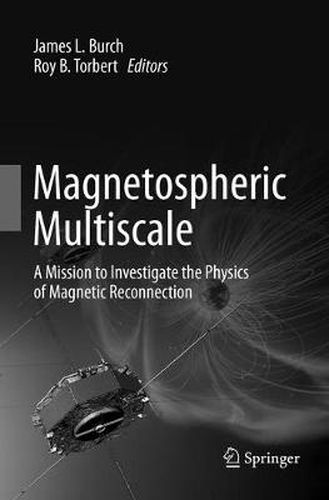Readings Newsletter
Become a Readings Member to make your shopping experience even easier.
Sign in or sign up for free!
You’re not far away from qualifying for FREE standard shipping within Australia
You’ve qualified for FREE standard shipping within Australia
The cart is loading…






NASA’s Magnetospheric Multiscale (MMS) mission is a four-spacecraft Solar Terrestrial Probe mission to study magnetic reconnection, a fundamental plasma physical process in which energy stored in a magnetic field is converted into the kinetic energy of charged particles and heat. The driver of eruptive solar events such as flares and coronal mass ejections, magnetic reconnection is also the process by which energy is transferred from the solar wind to Earth’s magnetosphere. Flying in a tetrahedral formation, the four identically instrumented MMS spacecraft measure the plasma, electric and magnetic fields, and energetic particles in the regions of geospace where magnetic reconnection is expected to occur. With interspacecraft distances varying from 400 km to 10 km and instruments capable of making extremely fast measurements (30 ms for electrons), MMS has the spatial and temporal resolution needed to resolve for the first time the microphysics of the electron diffusion region. Here, the magnetic field and the plasma become decoupled, allowing reconnection to occur. During the first of its two mission phases, MMS targets the dayside magnetopause, where the interplanetary and terrestrial magnetic fields reconnect. In the second phase, MMS increases its apogee from 12 RE to 25 RE and probes the nightside magnetosphere, where energy stored in the stretched field lines of the magnetotail is explosively released in magnetospheric substorms. Launched in March 2015 into a low-inclination elliptical orbit, MMS is now in Phase 1 of science operations.
This volume, which describes the MMS mission design, observatories, instrumentation, and operations, is aimed at researchers and graduate students in magnetospheric physics and plasma physics. Researchers using the publicly available MMS data will find it particularly useful.
Previously published in Space Science Reviews, Volume 199, Nos. 1-4, 2016.
$9.00 standard shipping within Australia
FREE standard shipping within Australia for orders over $100.00
Express & International shipping calculated at checkout
NASA’s Magnetospheric Multiscale (MMS) mission is a four-spacecraft Solar Terrestrial Probe mission to study magnetic reconnection, a fundamental plasma physical process in which energy stored in a magnetic field is converted into the kinetic energy of charged particles and heat. The driver of eruptive solar events such as flares and coronal mass ejections, magnetic reconnection is also the process by which energy is transferred from the solar wind to Earth’s magnetosphere. Flying in a tetrahedral formation, the four identically instrumented MMS spacecraft measure the plasma, electric and magnetic fields, and energetic particles in the regions of geospace where magnetic reconnection is expected to occur. With interspacecraft distances varying from 400 km to 10 km and instruments capable of making extremely fast measurements (30 ms for electrons), MMS has the spatial and temporal resolution needed to resolve for the first time the microphysics of the electron diffusion region. Here, the magnetic field and the plasma become decoupled, allowing reconnection to occur. During the first of its two mission phases, MMS targets the dayside magnetopause, where the interplanetary and terrestrial magnetic fields reconnect. In the second phase, MMS increases its apogee from 12 RE to 25 RE and probes the nightside magnetosphere, where energy stored in the stretched field lines of the magnetotail is explosively released in magnetospheric substorms. Launched in March 2015 into a low-inclination elliptical orbit, MMS is now in Phase 1 of science operations.
This volume, which describes the MMS mission design, observatories, instrumentation, and operations, is aimed at researchers and graduate students in magnetospheric physics and plasma physics. Researchers using the publicly available MMS data will find it particularly useful.
Previously published in Space Science Reviews, Volume 199, Nos. 1-4, 2016.